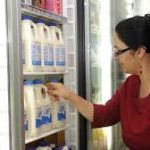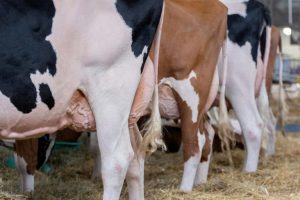
The 2020 Class III average stands at $18.39, up from $16.74 at this time a year ago and $14.69 in 2018. Tuesday’s December Class III futures contract settled at $15.39, which would portend an $18.14 average for 2020.
The Class IV price is $13.30, down 17 cents from October and $3.30 below a year ago. That put the 11-month average at $13.50, down from $16.26 a year ago and $14.15 in 2018.
Time to recalibrate?
Again the large gap between October and November Class III and Class I prices likely led to processor de-pooling and huge producer price differentials (PPDs), resulting in dairy farmers losing millions of dollars in revenue.
He said it’s a decades-old question and one of the issues is the complexity of the Federal order program. “When dairy farmers don’t understand exactly how their milk is being priced, there is some resistance to the system,” he said.
Federal orders also make export contracts more difficult, according to Fuess, and “Exports will be a key driver of dairy product disappearance and higher prices for farmers, hopefully in the future, if federal orders can be tweaked to allow longer term contracts to happen.”
As to negative PPDs, Fuess said, “They are a reflection of volatility in milk and for some farmers who are not necessarily seeing those negative PPDS, depending on the region, they have been extremely thankful for record high cheese prices.”
“Ultimately it’s the hope, and the system is designed so that PPDs average out close to the zero mark over the long term,” he reasoned. “If there’s something that can be done to even those out better on a month-to-month basis and allow farmers to receive the higher value of that cheese milk maybe there is something that could be looked at there.”
The system has been around since the 1930s, he said, and has prioritized Class I milk. “Perhaps a discussion can be had around having just one manufacturing class to allow milk to move to its highest value overall.”
“Federal orders have not been revised in any sort for more than 10 years,” Fuess said, “with make allowances being the same since prior to 2010 and there’s a question there as to what those numbers should be as well.”
He emphasized how important it is for dairy farmers to consider every risk management tool available. “Farmers have the power to vote orders out,” he concluded, “or processors can take a look at make allowances to see if there are other tweaks that could be made to the system that would benefit everyone.”
More help from Uncle Sam
The Agriculture Department announced that it will purchase $110 million worth of butter and fluid milk in 2021, using Section 32 funds. $50 million will be spent on butter and $60 million for fluid milk.
StoneX Dairy says that’s far less than the $142 million spent in Section 32 spending since May of this year, adding “We don’t have the actual solicitation yet, but this may have played into sentiment Monday as those buyers looking for coverage have largely discounted government purchase prospects. This solicitation doesn’t include cheese, but the thinking may be where there’s smoke there may in fact be some fire eventually.”
Cheese falls
Most CME dairy prices entered December a little stronger except cheese. The Cheddar blocks closed Dec. 4 at $1.5850 per pound, lowest since Aug. 11, down 9.5 cents on the week, and 38.5 cents below a year ago.
The barrels finished at $1.40, down 2.25 cents, 82.75 cents below a year ago, and 18.5 cents below the blocks. Eight cars of block were sold last week at the CME and 23 of barrel.
Monday’s trading saw the blocks gain a penny on an unfilled bid and then add 4.75 cents Tuesday, hitting $1.6425, on four trades.
The barrels were up a half-cent Monday on three bids and up 1.50 cents Tuesday, to $1.42, 22.25 cents below the blocks, with 11 cars exchanging hands.
Midwest cheesemakers reported widely available spot milk the week after Thanksgiving, according to Dairy Market News, and “wholly discounted.” Cheese producers say demand is steady to intermittent, with concern expressed that further restrictions on food service establishments due to COVID-19 will have further impact on sales.
The National Restaurant Association reports that “Since the COVID-19 pandemic began in March, 17% of restaurants (about 110,000 establishments) have closed either permanently or long-term, and 10,000 restaurants have closed over the last three months alone.”
Western cheese output is also active. Heavy milk volumes from the week of Thanksgiving kept facilities full and most plants were already at or near capacity. Manufacturers are hesitant to add much cheese to their inventories while milk prices are strong and cheese prices are falling. Demand for cheese from retail and pizza sectors is steady and solid, but food service demand is lacking, says DMN.
Butter saw daily gains last week and closed at $1.48 per pound, up 12 cents on the week but 43.5 cents below a year ago, on 34 sales reported.
Monday’s butter was up 4.50 cents and it gained a penny Tuesday, hitting $1.5350, highest since September 22. 12 cars were sold on Monday and 18 on Tuesday.
Some Central butter producers report fall volumes are moving quickly. Government orders have receded so they are focusing more on retail customers. Food service remains slow and contacts are still waiting for the full impact of COVID restaurant closures and restrictions. Cream has been, and is, widely available at declining prices and producers are unconcerned about finding cream for the rest of the month or year.
Western contacts expected lots of cream to be available over the Thanksgiving holiday weekend. As butter makers shift to end of year holiday orders, the underlying focus is to manage stocks.
Grade A nonfat dry milk climbed to $1.1575 per pound Thursday, highest since February 21, but closed Friday at $1.15, still 5.5 cents higher on the week and 11.75 cents below a year ago. There were 25 sales reported on the week.
The powder was unchanged Monday and Tuesday.
CME dry whey climbed to a 46.25 cents per pound close Dec. 4, up 3.25 cents on the week and 9.5 cents above a year ago, with 5 sales reported for the week.
Traders left the whey unchanged Monday but inched it up a quarter-cent Tuesday, to 46.50 cents per pound, highest since January 18, 2019.
More powder and butter
You’ll recall October milk output hit 18.56 billion pounds, up 2.3% from 2019. The October Dairy Products report shows that more of that milk went to powder and butter.
Cheese output totaled 1.13 billion pounds, up 3.2% from September, but 0.6% below October 2019. Year to date total cheese sits at 10.96 billion pounds, up just 0.4% from a year ago.
Wisconsin produced 286 million pounds of that October total, up 2.8% from September but 0.9% below a year ago. California output hit 200.6 million pounds, up 4.1% from September but 7.1% below a year ago. Idaho, with 86 million pounds, was down 1.2% from September and 1.0% below a year ago.
Italian type cheese totaled 469.2 million pounds, up 1.3% from September but 3.4% below a year ago. YTD Italian was at 4.7 billion pounds, down 1.2%.
American type cheese totaled 461.1 million pounds, up 6.1% from September and 3.5% above a year ago. YTD American was at 4.4 billion pounds, up 2.0%.
Mozzarella output was at 366 million pounds, down 4.8% from a year ago, with YTD at 3.7 billion pounds, down 1.4% from 2019.
Cheddar, which trades daily at the CME, climbed to 326.9 million pounds, highest October volume ever, up 19.9 million pounds or 6.5% from September and 17.3 million or 5.6% above October 2019. YTD Cheddar is at 3.2 billion pounds, up 2.7% from a year ago.
Butter churns produced 164.9 million pounds, up 13.3 million pounds or 8.8% from September and 2 million pounds or 1.2% above a year ago. YTD butter is at 1.7 billion pounds, up 5.9% from 2019.
Yogurt production totaled 382.9 million pounds, up 7.1% from a year ago, with the YTD total at 3.8 billion pounds, up 2.3%
Dry whey totaled 80.2 million pounds, up 5.4 million or 7.2% from September but 10.6 million or 11.8% below a year ago, with YTD at 810.6 million pounds, down 1.5%.
Dry whey stocks totaled 68.1 million pounds, down 14.3% from September and 14.2% below a year ago.
Nonfat dry milk climbed to 138.4 million pounds, up 12.4 million pounds or 9.8% from September and 5.7 million or 4.3% above a year ago. YTD powder sits at 1.6 billion pounds, up 2.1% from 2019.
Stocks, at 234.9 million pounds, were up 1.6 million or 0.7% from September, but 17 million or 7.8% above a year ago.
Skim milk powder output fell to 57.2 million pounds, down 15.3 million pounds or 21.1% from September but 9.8 million pounds or 20.7% above a year ago. YTD skim milk powder is at 510.2 million pounds, up a hefty 11.7% from a year ago.























